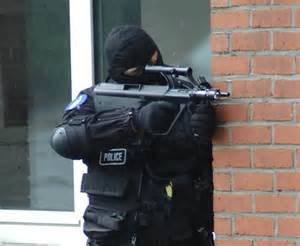Terrorism is not an enemy. It is the state of imagining an enemy, while the agent of terror does everything in his or her power to provoke that imagination.
An enemy is an opponent who seeks to take something from me, something tangible and factual. It is possible to see his face and watch the direction of his eyes and body for the thing he desires and wishes to take into his possession. Even though terrorists may ultimately seek something tangible and factual, their practice is to hide their faces and bodies before and as they attack so that we imagine them first: amorphous, monstrous, unappeasable.
Terrorism is the pure metaphysics of violence. It is violence “itself.” The terrorist wishes to take away my peace, my whole world, not just part of it. Terrorism is the battle of the dispossessed against the whole world which dispossessed and excluded them in the first place. A terrorist is a mirrorist.
Terrorism is a way of being in a world where institutions have failed. Armies, uniforms, governments, universities, books, laws and lawyers, all that is irrelevant to the pure imagination of the terrorist.
If we direct our anger against named groups like Isis or Al Qaeda, with governments declaring war against them, we lose the underlying dynamic of terror. Attacking hard targets mistakes the phenomenon of Isis for a conventional enemy. The U.S. understands this. This is why the U.S. air strikes have made no difference and were never intended to make a difference. Why is the U.S. just now attacking oil trucks while they could have consistently done this before if they thought they were realistically at war? Russia and France believe they can do a better job, and it is probably now just window dressing on the part of the U.S. in response. There are many who believe the U.S. actually created Isis for strategic purposes. Whatever the case the U.S. seems content with a low level permanent war, one that exists on the basis of the metaphysics of violence. There appears to be a synergy between the military industrial media complex and the metaphysics of violence. As Girard says, “Choose your enemies carefully, because you will become like them.” But after a while it is difficult to say who is choosing whom.
declaring war against them, we lose the underlying dynamic of terror. Attacking hard targets mistakes the phenomenon of Isis for a conventional enemy. The U.S. understands this. This is why the U.S. air strikes have made no difference and were never intended to make a difference. Why is the U.S. just now attacking oil trucks while they could have consistently done this before if they thought they were realistically at war? Russia and France believe they can do a better job, and it is probably now just window dressing on the part of the U.S. in response. There are many who believe the U.S. actually created Isis for strategic purposes. Whatever the case the U.S. seems content with a low level permanent war, one that exists on the basis of the metaphysics of violence. There appears to be a synergy between the military industrial media complex and the metaphysics of violence. As Girard says, “Choose your enemies carefully, because you will become like them.” But after a while it is difficult to say who is choosing whom. 
The truth is that terrorism is a condition of chaos and it exists at many levels. It belongs to the loss of authority and the loss of meaning inherent in the collapse of sacrificial foundations. It is a way of being in the world, and the most knowing elements in international arms and politics understand this and exploit it. In comparison Putin is an old-fashioned cold war balance of power rationalist.
Girard in his way is a similar rationalist. In his final book, Battling to the End, he presented the rivalry between the great powers as the ratio of a duel, which becomes a final irrationality as they fight “to the end.” However, the terrorist is not a rival in this sense. He is militarily, materially, financially and politically no match for the great powers. And yet culturally he is. Why? Because by the use of modern media, brutal personal violence and the choice of soft targets at the heart of Western secularism he is able to achieve a reverberating symmetry with his cultural rival. Girard did not see the extreme asymmetry/symmetry or non-ratio/ratio of terrorism, and thus he did not appear to see the particular character of the crisis that resides, not simply at the end of rivalry, but in a paradoxical opposition of the single individual to the whole. It is precisely at this point that a solution begins to offer itself.
The single individual removed from the whole is a deeply Christian phenomenon. It goes back to the early nonviolent martyrs and, of course, to Jesus himself. Kierkegaard made it a central theme, in contrast to the Hegelian system. In our contemporary world Edward Snowden and Chelsea Manning are powerful examples, and even the present pope, Francis, may be interpreted as such in relation to the Vatican curia and hierarchy. Thus within the depth of terrorism we might say there is the seed of its own overcoming. Not with the force of bombing or a vast army on the ground in the Middle East (the 21st century crusade that Islamic metaphysicians are longing for). None of that will counter the rivalry of the individual against the hegemonic whole. But the example of the nonviolent individual who is prepared to stand in dynamic contrast to the world, without entering into rivalry with its metaphysical violence, this is an irreducible point of meaning–one that can only continue to grow in power.
It is not the suicide bomber who is the real antagonist of the hegemonic state (he is already thoroughly co-opted). It is Jesus who has taught us how to be individuals, even the extremists who abuse the gift. His nonviolent assymetry/symmetry is an act of love which calls the whole to love. Jesus sets himself over against the world, not in violence but love. He is the original mirrorist, but with an impossible mirroring of love. Only love can mirror something that is not there in the first place.
![th[4]](http://hopeintime.com/wp-content/uploads/2015/11/th4-300x180.jpg)
Hello Dr. Bartlett,
My name is Tim Catchim. I loved your book Cross Purposes. I am in the process of developing some curriculum/discipling tools to help unpack some of your ideas. Would you be open to a conversation? Thanks for considering it.
Hi Tim, certainly I would be open to a conversation about those things. At tonywbartlett@gmail.com. Peace and best wishes.